Mizoram polls: In historical MNF-Congress battle, ZPM an emerging force
Since it became a state in 1987, Mizoram has only had Congress and MNF governments. The BJP won its first seat in the state in 2018
 The MNF’s Zoramthanga first became the CM after the Assembly polls in 1998, when the party ended the Congress’s 10-year rule. (File Photo/PTI)
The MNF’s Zoramthanga first became the CM after the Assembly polls in 1998, when the party ended the Congress’s 10-year rule. (File Photo/PTI) In 1972, Mizoram was carved out of Assam, initially as a Union Territory until it became a full state in 1987. Since then, state politics has been dominated by the Congress and Mizo National Front (MNF).
The Congress has long been led by five-time Chief Minister Lal Thanhawla, who first got the top post in 1984. But this time, it has handed over the baton to Lalsawta, a three-time MLA and former finance minister who heads the state unit. Lalsawta is also the Congress’s candidate against the MNF’s Zoramthanga, a three-time CM who is again leading the party into the polls.
The MNF was founded in 1955, initially as Mizo Cultural Society, an activist group that protested against government inaction during a famine in the Mizo hills when it was still a part of Assam. By 1960, it was renamed the Mizo National Famine Front and, a year later, it had become an insurgent outfit demanding autonomy for the Mizo hills region. It eventually became the Mizo National Front, which launched a secessionist movement in 1966 and fought the government for almost 20 years until the Mizoram Peace Accord was signed in 1986. The Accord granted Mizoram statehood, and then MNF chief Laldenga became the state’s first CM.
Since 1986, the MNF and Congress have been in power for about two decades each. No other party, regional or otherwise, has been able to dislodge the two. Even the BJP has had little success in the tribal (39 of the 40 Assembly seats reserved for Scheduled Tribes) and Christian-majority state that borders Bangladesh and Myanmar.
It’s no surprise then that parties like the MNF and the recently ascendant Zoram People’s Movement, led by retired IPS officer Lalduhoma, are centring the 2023 campaign on regional identity to ward off the challenge from the Congress and the BJP ahead of voting on November 7.
Parties and past four polls
The MNF’s Zoramthanga first became the CM after the Assembly polls in 1998, when the party ended the Congress’s 10-year rule. The MNF was then in power for the next 10 years, until consecutive Congress victories in 2008 and 2013. The MNF returned to power in 2018 and is seeking another consecutive win in the 40-member Assembly this year.
In each of the last four Assembly elections, the single-largest party has also managed to cross the majority mark and form the government without any allies. But with the presence of numerous regional parties, none has been able to breach the 40% vote share mark, except the Congress in its 2013 win.
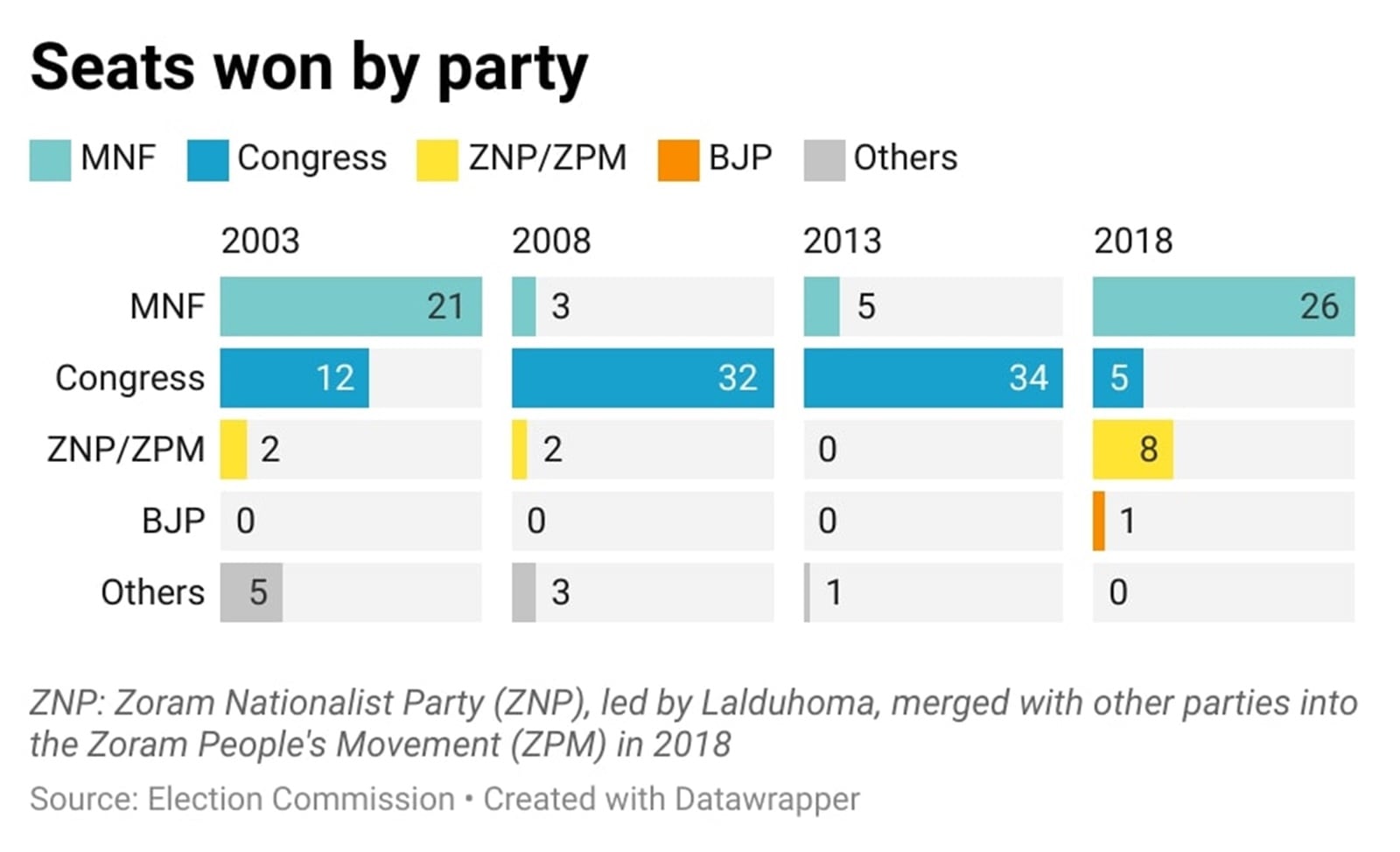
In each of the last four Assembly elections, the single-largest party has also managed to cross the majority mark and form the government without any allies.
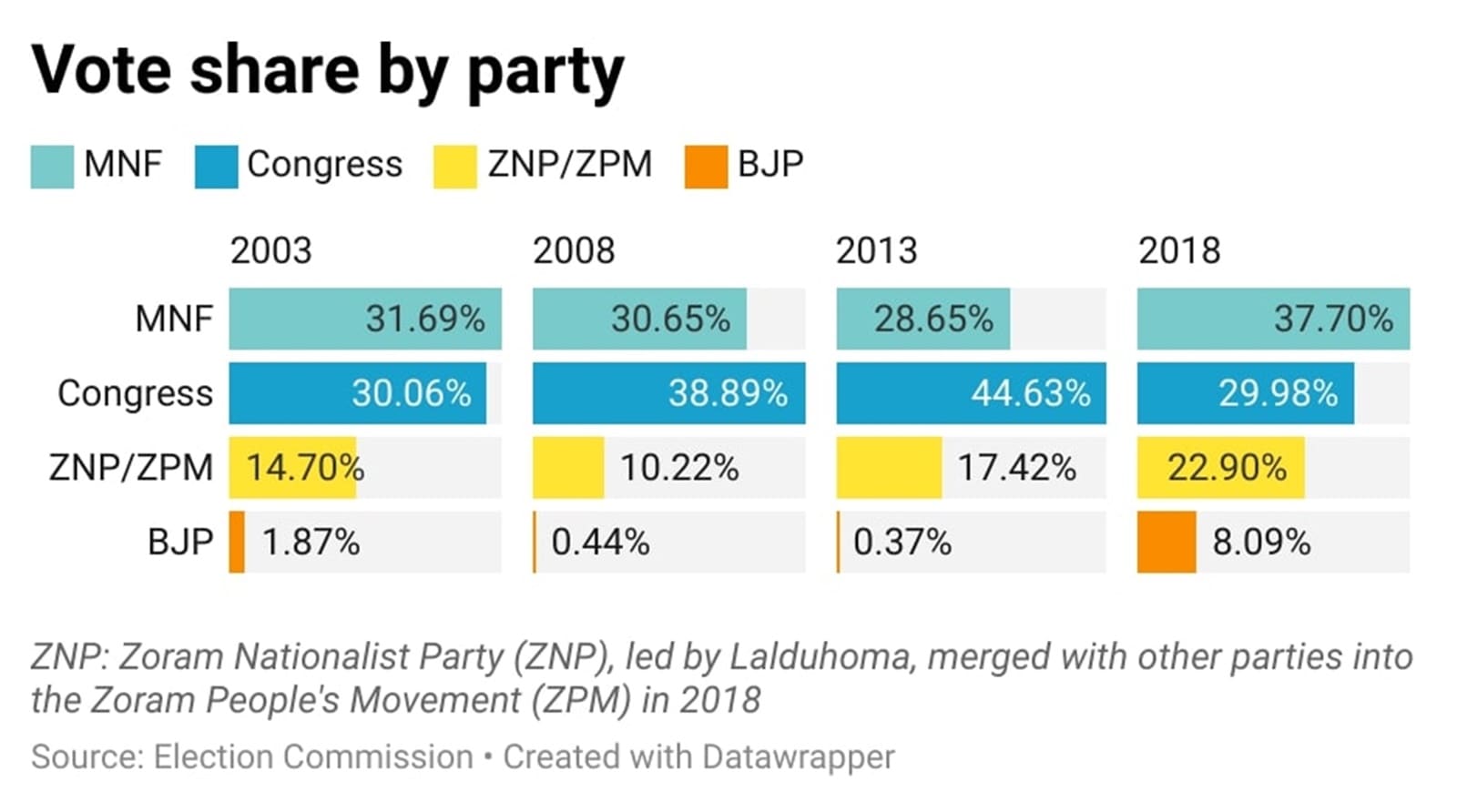 With the presence of numerous regional parties, none has been able to breach the 40% vote share mark, except the Congress in its 2013 win.
With the presence of numerous regional parties, none has been able to breach the 40% vote share mark, except the Congress in its 2013 win.
2003 polls
In 2003, the MNF had returned to power with 21 seats, with Zoramthanga becoming CM for the second time. While the MNF’s seat tally was unchanged from 1998, the Congress doubled it from 6 to 12. In terms of vote share though, just 1.63% separated the two parties.
Among the other notable parties in these polls were the Zoram Nationalist Party (ZNP) and the Mizoram People’s Conference (MPC), which won 2 and 5 seats, respectively. Their vote shares, though, were significant at 14.7% and 16.16%, respectively.
The ZNP at the time was led by Lalduhoma, who is now the president of the Zoram People’s Movement. It was formed initially as a splinter group from the MNF. The MPC, having been the primary Opposition party before the MNF became a political outfit, has been in continuous decline since 1998, when it had won 12 seats. The MPC’s leader at the time, T Sailo, had even been a two-time CM before Mizoram was granted statehood.
2008 polls
The Congress came to power with a comfortable majority of 32 seats, cutting the MNF’s seat tally to just 3, while the ZNP and MPC won 2 and 3 seats, respectively. The Congress’s Lal Thanhawla became CM for the fourth time.
While the Congress raised its vote share to 38.89%, the MNF, ZNP and MPC all declined from 2003, with their vote shares falling to 30.65%, 10.22% and 10.38%.
The MNF’s defeat was partly attributed to corruption allegations levelled against Zoramthanga ahead of the 2008 polls. He was investigated by the Mizoram Police’s Anti-Corruption Bureau but was eventually acquitted in 2021.
Among the notable non-Congress winners were Lalduhoma and T Sailo, but Zoramthanga was unable to win from either of the two seats he contested.
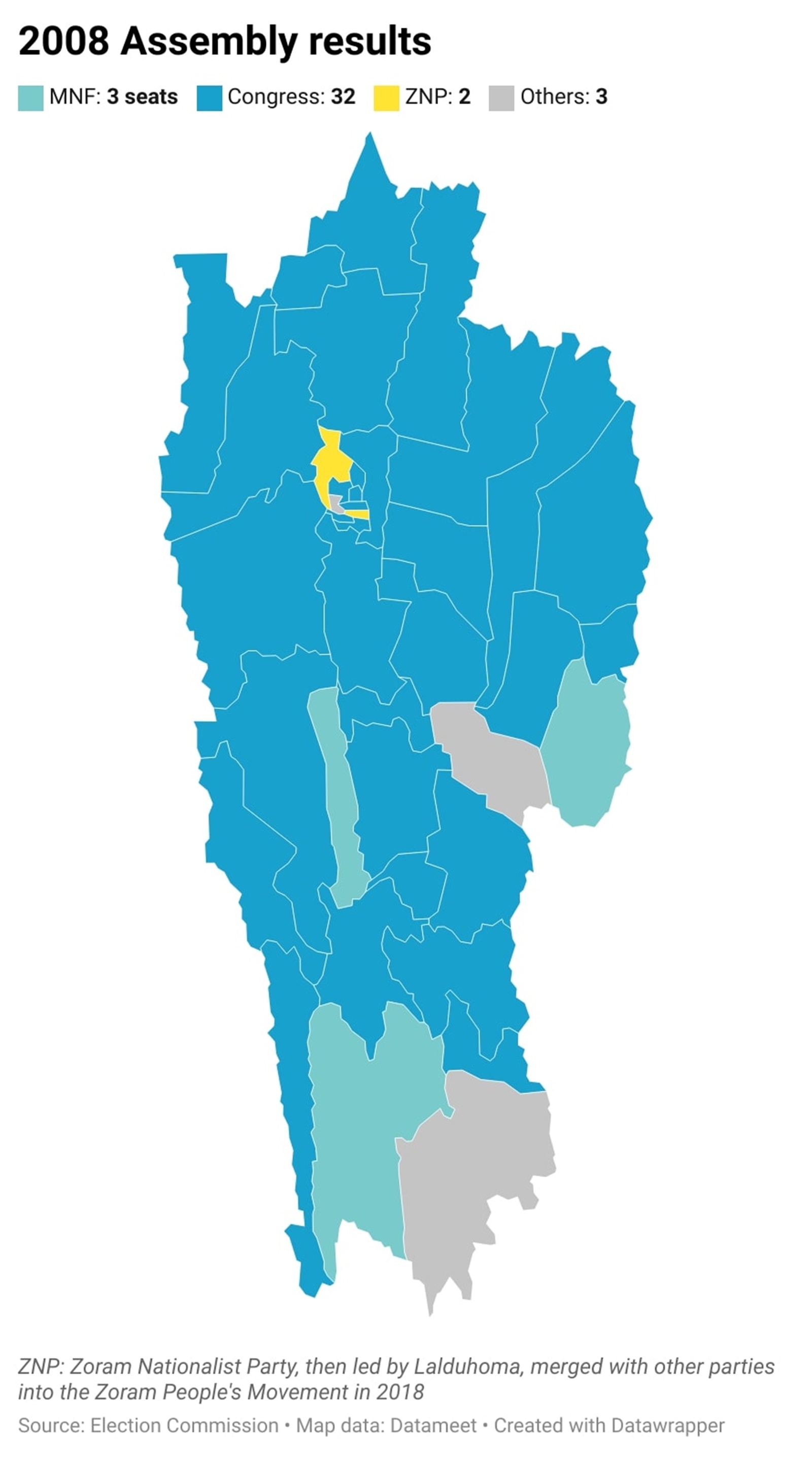 The Congress came to power with a comfortable majority of 32 seats, cutting the MNF’s seat tally to just 3, while the ZNP and MPC won 2 and 3 seats, respectively.
The Congress came to power with a comfortable majority of 32 seats, cutting the MNF’s seat tally to just 3, while the ZNP and MPC won 2 and 3 seats, respectively.
2013 polls
The Congress returned to power with a record-breaking victory, winning 34 seats and 44.63% of the vote share, both the highest in the state’s history. Lal Thanhawla, the state’s longest-serving CM, won his fifth term in office. The MNF increased its seat tally from 2008 to 5, but its vote share fell to 28.65%.
The Congress was able to fight off anti-incumbency with popular welfare programmes like the New Land Use Policy Scheme, which was launched in 2008 to provide Rs 1 lakh, either in cash or in kind, to families of farmers, small businessmen or small industrialists.
The Congress saw off the challenge from the Mizoram Democratic Alliance – a three-party alliance of the MNF, MPC and the Maraland Democratic Front.
While the MPC won 1 seat with 6.15% of the vote, the ZNP failed to win any despite winning 17.42% vote share.
While the MPC’s Sailo retired from politics by the 2013 polls, neither Zoramthanga nor Lalduhoma were able to win their seats.
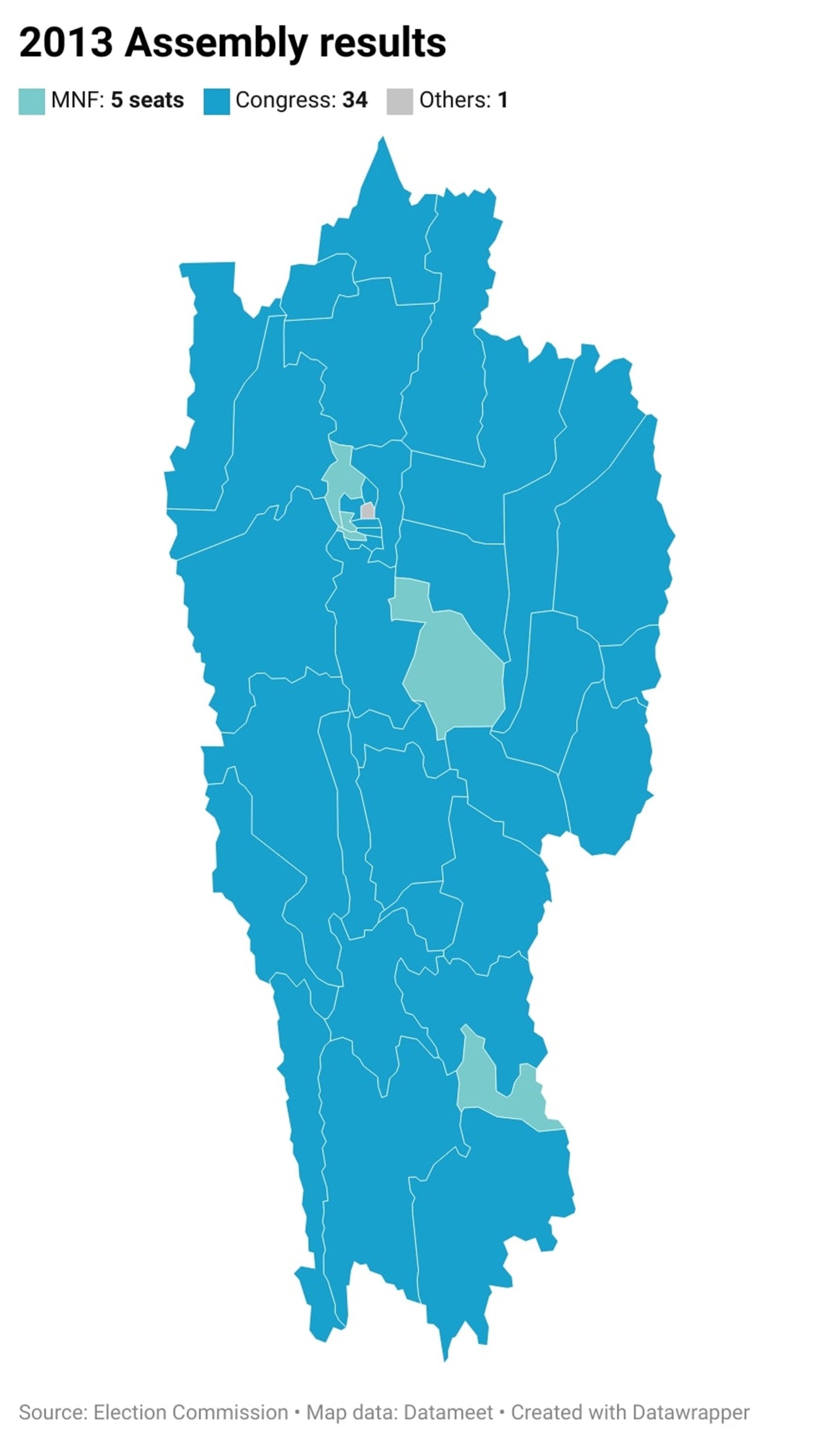 The Congress returned to power with a record-breaking victory, winning 34 seats and 44.63% of the vote share, both the highest in the state’s history.
The Congress returned to power with a record-breaking victory, winning 34 seats and 44.63% of the vote share, both the highest in the state’s history.
2018 polls
The 2018 elections saw a reversal of the past two polls, with the MNF winning its highest ever seat tally of 26 and reducing the Congress to just 5. In terms of vote share, too, the MNF recorded its best performance since 1993 at 37.7%. Zoramthanga became the CM for the third time.
Though the Congress won 29.98% of the vote share, it was surpassed by the Lalduhoma-led Zoram People’s Movement (ZPM), which won 8 seats with 22.9% of the vote share. Though the ZPM candidates had fought the polls as Independents, they came together as a political party after the results were announced. The ZPM has enjoyed a recent boost in its stature, winning several local elections, including in Zoramthanga’s home turf of Aizawl East 1 constituency.
With 1 seat and 8.09% of the vote share, the BJP opened its Mizoram account in these polls. In 2023, the party is eyeing the Christian-majority state’s non-Mizo voters, though it faces an uphill task in shedding its national-level Hindutva stance.
Anti-incumbency proved too much to overcome for the Congress. Lalsawta, now the party’s state unit president and CM candidate, finished third in the Aizawl East 2 seat. Sitting CM Lal Thanhawla also lost, with the end of his term marked by investigations into irregularities in his election affidavits.
Among the key poll issues was prohibition. The Congress had lifted the alcohol ban in the state, which the MNF had promised to reverse, a stance that was backed by the state’s influential Church. The MNF’s promises of socio-economic development programmes, including assistance to farmers and improvements in the agriculture market ecosystem, also proved popular among voters.
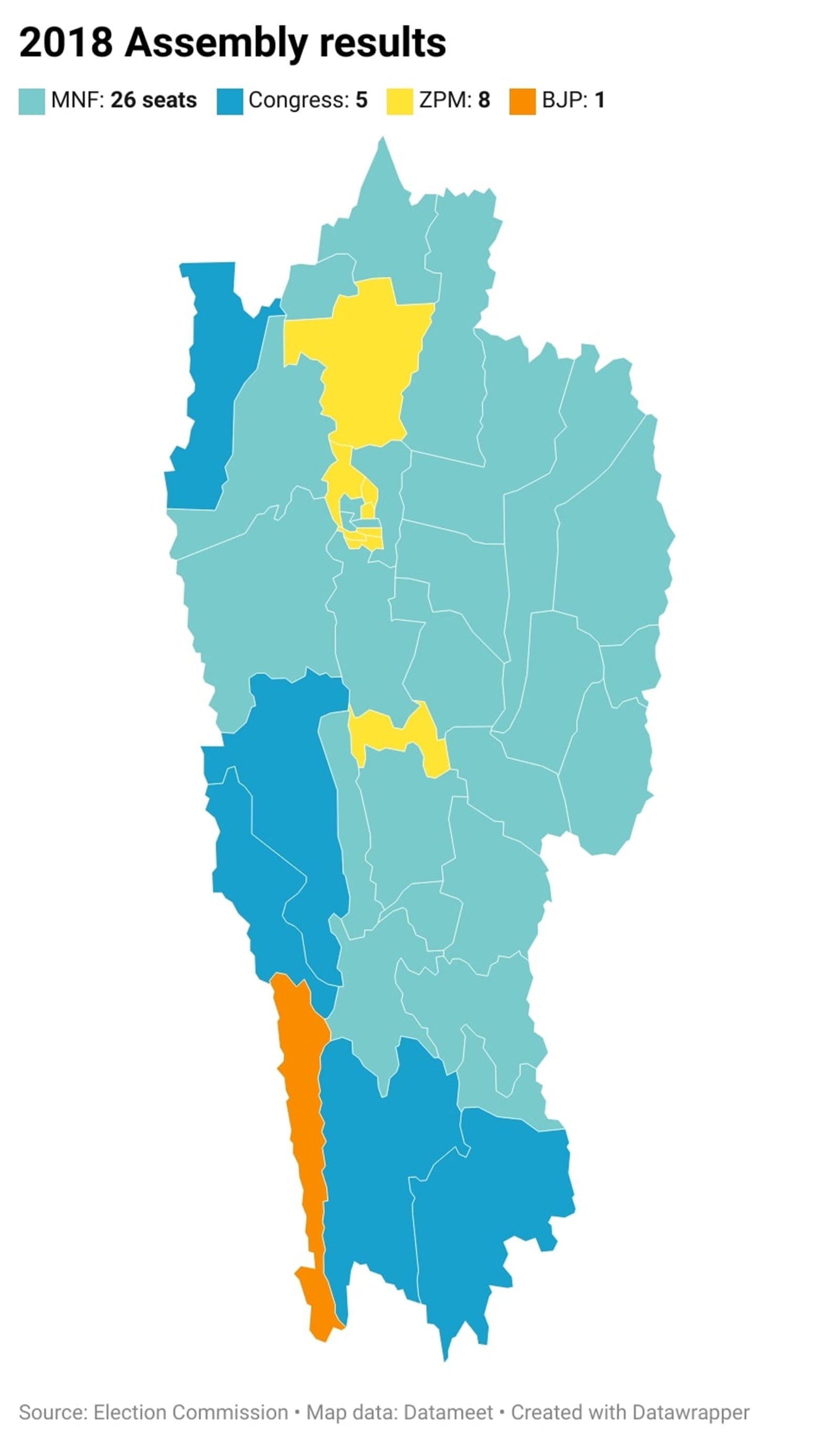 The 2018 elections saw a reversal of the past two polls, with the MNF winning its highest ever seat tally of 26 and reducing the Congress to just 5.
The 2018 elections saw a reversal of the past two polls, with the MNF winning its highest ever seat tally of 26 and reducing the Congress to just 5.
2019 Lok Sabha polls
After its 2018 Assembly poll win, the MNF comfortably won the state’s only Lok Sabha seat with 45.12% of the vote share. While the Congress did not contest, the BJP only managed to win 5.78% of the vote share.
- 01
- 02
- 03
- 04
- 05































